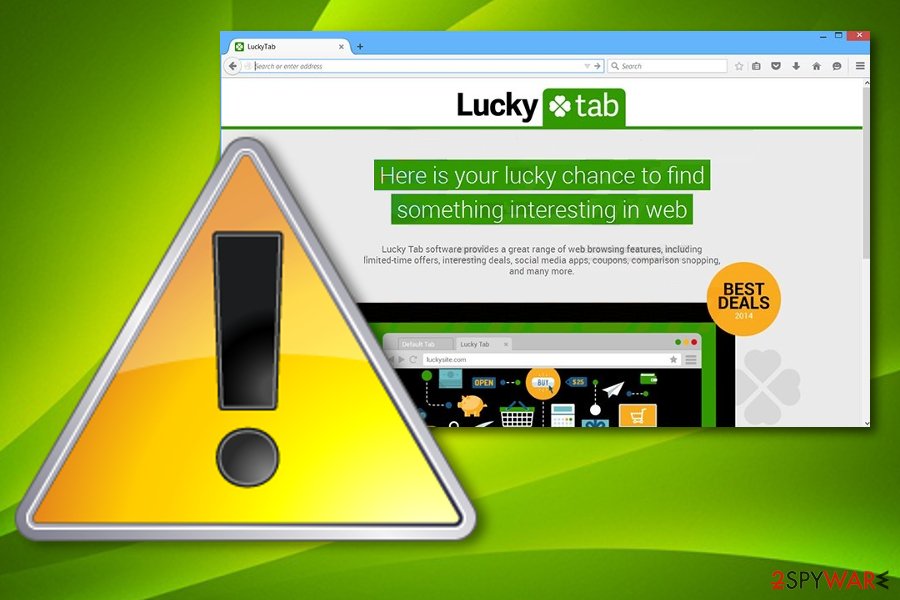LuckyTab virus (Removal Instructions) - updated Oct 2019
LuckyTab virus Removal Guide
What is LuckyTab virus?
LuckyTab – adware-related software that claims to provide a wide range of beneficial functions

LuckyTab is a bogus adware-based[1] extension that claims to provide various browsing features such as viewing coupons, entering shopping websites, etc. The adware may display intrusive advertisements on each of your web browsers and try to trick you in various ways. Redirecting is also another annoying feature of LuckyTab that might relate to you landing on an infected source. Also, the PUP may infiltrate your computer silently without direct permission asked and that's the first signal indicating that you should not use this application. Due to an unfair method of infiltration, it has been categorized as a potentially unwanted program (PUP).
| Name | LuckyTab |
|---|---|
| Type | Potentially unwanted program |
| Sub-type | Adware application |
| Activities | This suspicious program supports activities such as advertising, redirecting, collecting non-personal information regarding the user's browsing activities |
| Goal | The main goal of this adware is to collect income from the advertisements that are displayed |
| Removal | Scan your system with FortectIntego to find all hiding spots of potentially unwanted content. Afterward, eliminate the PUP manually or automatically (see instructions at the end of this article) |
Once LuckyTab virus is inside it may take over all web browsers that are installed on your PC, including Google Chrome, Mozilla Firefox, and Internet Explorer. Be aware that this add-on was specifically designed to make money for third parties by generating web traffic to affiliate websites.
Once LuckyTab drops its extension, it delivers an excessive amount of “Ads by LuckyTab” that usually appear as pop-ups and banners on random websites that you visit. At best, by clicking on them you may be redirected to certain online shopping websites or various service offering website.
At worst, this LuckyTab redirects may force you to visit unsafe websites and trick into installing questionable programs, such as another potentially unwanted program or even virus. Not to mention, if you would get tempted to buy something there, you may even get scammed.

Finally, you should be aware that LuckyTab virus may try to collect personal and non-personal information related to your browsing habits and use gathered information for affiliate marketing. Personal data mostly refers to the user's email address, mobile phone number.
However, it rarely happens that adware targets personal information. LuckyTab is more likely to capture browsing-related details such as commonly visited websites, hyperlinks clicked, saved bookmarks, your IP address, geolocation, commonly searched offers and deals, etc.
LuckyTab removal is a necessary process to perform if you want to get rid of all of the annoying activities that are promoted by the potentially unwanted program. You can scan your computer with FortectIntego and try locating all suspicious content on your machine. However, manual removal is also possible.
You can remove LuckyTab by using the step-by-step guidelines that are added at the end of this article. There you will find instructions on how to get rid of the adware from both macOS and Windows OS. Browser cleaning is also important in order to eliminate the threat entirely.
In some cases, you might start seeing ads from LuckyTab while visiting bogus third-party networks. If this started happening to you, you can try downloading an adblocking tool such as AdBlock[2] straight to the web browser on which you have been experiencing the advertising.

Ways through which adware programs reach computer systems
Potentially unwanted programs, including adware, typically infiltrate the system along with free software. You should beware that the majority of free programs that are promoted on various third party websites are bundled with optional downloads. Even though “bundling” is not considered as an illegal or unfair distribution method, nowadays it is mainly used for distributing potentially unwanted programs.
Research shows that users get suspicious products mostly from sources such as download.com, softonic.com, soft32.com, cnet.com, and others. Therefore, it is advisable to pay more attention while choosing and downloading free applications from the Internet in order to avoid installing potentially unwanted programs. Avoid Recommended or Quick installation because this way you may automatically agree to install additional applications alongside your chosen software.
Instead of it choose Advanced or Custom installation mode as it discloses all available checkboxes, including the ones that offer to install additional components. If you spot a checkbox claiming that you accept to install a “recommended” plug-in, add-on, toolbar, or extension, we recommend deselecting it because, otherwise, you may end up with another adware and potentially unwanted program on your computer.
Remove LuckyTab virus from your computer
LuckyTab virus removal is a process that is supported by both manual and automatical techniques. We have provided step-by-step guidelines down below that should help you to clean your Windows/Mac computer and refresh web browser apps such as Google Chrome, Mozilla Firefox, Internet Explorer, Microsoft Edge, and Safari.
However, if you find yourself hardly capable of eliminating the adware, you can always rely on automatical software that will help you to remove LuckyTab virus automatically. You can choose a tool from our below-provided list or any other program from your own likings.
According to experts from Virusai.lt,[3] you need to make sure that suspicious content related to LuckyTab virus is permanently removed from both the operating system and web browsers, otherwise, the adware might have a chance of returning with all of its activities the next time you boot your machine.
You may remove virus damage with a help of FortectIntego. SpyHunter 5Combo Cleaner and Malwarebytes are recommended to detect potentially unwanted programs and viruses with all their files and registry entries that are related to them.
Getting rid of LuckyTab virus. Follow these steps
Uninstall from Windows
To remove the adware from your Windows computer system, perform these tasks.
Instructions for Windows 10/8 machines:
- Enter Control Panel into Windows search box and hit Enter or click on the search result.
- Under Programs, select Uninstall a program.

- From the list, find the entry of the suspicious program.
- Right-click on the application and select Uninstall.
- If User Account Control shows up, click Yes.
- Wait till uninstallation process is complete and click OK.

If you are Windows 7/XP user, proceed with the following instructions:
- Click on Windows Start > Control Panel located on the right pane (if you are Windows XP user, click on Add/Remove Programs).
- In Control Panel, select Programs > Uninstall a program.

- Pick the unwanted application by clicking on it once.
- At the top, click Uninstall/Change.
- In the confirmation prompt, pick Yes.
- Click OK once the removal process is finished.
Delete from macOS
Remove items from Applications folder:
- From the menu bar, select Go > Applications.
- In the Applications folder, look for all related entries.
- Click on the app and drag it to Trash (or right-click and pick Move to Trash)

To fully remove an unwanted app, you need to access Application Support, LaunchAgents, and LaunchDaemons folders and delete relevant files:
- Select Go > Go to Folder.
- Enter /Library/Application Support and click Go or press Enter.
- In the Application Support folder, look for any dubious entries and then delete them.
- Now enter /Library/LaunchAgents and /Library/LaunchDaemons folders the same way and terminate all the related .plist files.

Remove from Microsoft Edge
Delete unwanted extensions from MS Edge:
- Select Menu (three horizontal dots at the top-right of the browser window) and pick Extensions.
- From the list, pick the extension and click on the Gear icon.
- Click on Uninstall at the bottom.

Clear cookies and other browser data:
- Click on the Menu (three horizontal dots at the top-right of the browser window) and select Privacy & security.
- Under Clear browsing data, pick Choose what to clear.
- Select everything (apart from passwords, although you might want to include Media licenses as well, if applicable) and click on Clear.

Restore new tab and homepage settings:
- Click the menu icon and choose Settings.
- Then find On startup section.
- Click Disable if you found any suspicious domain.
Reset MS Edge if the above steps did not work:
- Press on Ctrl + Shift + Esc to open Task Manager.
- Click on More details arrow at the bottom of the window.
- Select Details tab.
- Now scroll down and locate every entry with Microsoft Edge name in it. Right-click on each of them and select End Task to stop MS Edge from running.

If this solution failed to help you, you need to use an advanced Edge reset method. Note that you need to backup your data before proceeding.
- Find the following folder on your computer: C:\\Users\\%username%\\AppData\\Local\\Packages\\Microsoft.MicrosoftEdge_8wekyb3d8bbwe.
- Press Ctrl + A on your keyboard to select all folders.
- Right-click on them and pick Delete

- Now right-click on the Start button and pick Windows PowerShell (Admin).
- When the new window opens, copy and paste the following command, and then press Enter:
Get-AppXPackage -AllUsers -Name Microsoft.MicrosoftEdge | Foreach {Add-AppxPackage -DisableDevelopmentMode -Register “$($_.InstallLocation)\\AppXManifest.xml” -Verbose

Instructions for Chromium-based Edge
Delete extensions from MS Edge (Chromium):
- Open Edge and click select Settings > Extensions.
- Delete unwanted extensions by clicking Remove.

Clear cache and site data:
- Click on Menu and go to Settings.
- Select Privacy, search and services.
- Under Clear browsing data, pick Choose what to clear.
- Under Time range, pick All time.
- Select Clear now.

Reset Chromium-based MS Edge:
- Click on Menu and select Settings.
- On the left side, pick Reset settings.
- Select Restore settings to their default values.
- Confirm with Reset.

Remove from Mozilla Firefox (FF)
To clean Firefox from suspicious content that has been added by the adware, complete the following.
Remove dangerous extensions:
- Open Mozilla Firefox browser and click on the Menu (three horizontal lines at the top-right of the window).
- Select Add-ons.
- In here, select unwanted plugin and click Remove.

Reset the homepage:
- Click three horizontal lines at the top right corner to open the menu.
- Choose Options.
- Under Home options, enter your preferred site that will open every time you newly open the Mozilla Firefox.
Clear cookies and site data:
- Click Menu and pick Settings.
- Go to Privacy & Security section.
- Scroll down to locate Cookies and Site Data.
- Click on Clear Data…
- Select Cookies and Site Data, as well as Cached Web Content and press Clear.

Reset Mozilla Firefox
If clearing the browser as explained above did not help, reset Mozilla Firefox:
- Open Mozilla Firefox browser and click the Menu.
- Go to Help and then choose Troubleshooting Information.

- Under Give Firefox a tune up section, click on Refresh Firefox…
- Once the pop-up shows up, confirm the action by pressing on Refresh Firefox.

Remove from Google Chrome
To refresh Google Chrome after the adware attack, take a look at the following steps.
Delete malicious extensions from Google Chrome:
- Open Google Chrome, click on the Menu (three vertical dots at the top-right corner) and select More tools > Extensions.
- In the newly opened window, you will see all the installed extensions. Uninstall all the suspicious plugins that might be related to the unwanted program by clicking Remove.

Clear cache and web data from Chrome:
- Click on Menu and pick Settings.
- Under Privacy and security, select Clear browsing data.
- Select Browsing history, Cookies and other site data, as well as Cached images and files.
- Click Clear data.

Change your homepage:
- Click menu and choose Settings.
- Look for a suspicious site in the On startup section.
- Click on Open a specific or set of pages and click on three dots to find the Remove option.
Reset Google Chrome:
If the previous methods did not help you, reset Google Chrome to eliminate all the unwanted components:
- Click on Menu and select Settings.
- In the Settings, scroll down and click Advanced.
- Scroll down and locate Reset and clean up section.
- Now click Restore settings to their original defaults.
- Confirm with Reset settings.

Delete from Safari
Remove unwanted extensions from Safari:
- Click Safari > Preferences…
- In the new window, pick Extensions.
- Select the unwanted extension and select Uninstall.

Clear cookies and other website data from Safari:
- Click Safari > Clear History…
- From the drop-down menu under Clear, pick all history.
- Confirm with Clear History.

Reset Safari if the above-mentioned steps did not help you:
- Click Safari > Preferences…
- Go to Advanced tab.
- Tick the Show Develop menu in menu bar.
- From the menu bar, click Develop, and then select Empty Caches.

After uninstalling this potentially unwanted program (PUP) and fixing each of your web browsers, we recommend you to scan your PC system with a reputable anti-spyware. This will help you to get rid of LuckyTab registry traces and will also identify related parasites or possible malware infections on your computer. For that you can use our top-rated malware remover: FortectIntego, SpyHunter 5Combo Cleaner or Malwarebytes.
How to prevent from getting adware
Access your website securely from any location
When you work on the domain, site, blog, or different project that requires constant management, content creation, or coding, you may need to connect to the server and content management service more often. The best solution for creating a tighter network could be a dedicated/fixed IP address.
If you make your IP address static and set to your device, you can connect to the CMS from any location and do not create any additional issues for the server or network manager that needs to monitor connections and activities. VPN software providers like Private Internet Access can help you with such settings and offer the option to control the online reputation and manage projects easily from any part of the world.
Recover files after data-affecting malware attacks
While much of the data can be accidentally deleted due to various reasons, malware is one of the main culprits that can cause loss of pictures, documents, videos, and other important files. More serious malware infections lead to significant data loss when your documents, system files, and images get encrypted. In particular, ransomware is is a type of malware that focuses on such functions, so your files become useless without an ability to access them.
Even though there is little to no possibility to recover after file-locking threats, some applications have features for data recovery in the system. In some cases, Data Recovery Pro can also help to recover at least some portion of your data after data-locking virus infection or general cyber infection.
- ^ Adware. Wikipedia. The free encyclopedia.
- ^ What is AdBlock?. Quora.com. Relevant questions and answers.
- ^ Virusai.lt. Virusai.lt. Spyware and security news.























